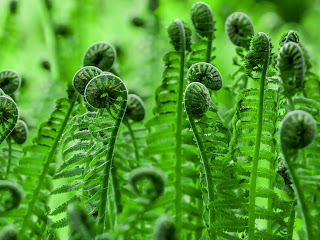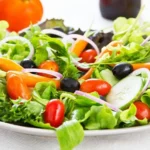
Fiddlehead is an early stage in the fern life cycle when young shoots are curled up tightly at the top and shaped like a seahorse. Most of the species of ferns used in human nutrition are found in the temperate zones of the northern hemisphere in damp, shady locations and usually grow near streams, in damp forests and open meadows. Fiddleheads have been part of human diet for centuries. They are not grown, but collected from nature and only consumed in spring.
Fiddleheads are older than dinosaurs! By over 100 million years!
Fiddleheads of most species of fern are usually one or two inches long, while coiled part is one inch wide.
During the Middle Ages, people thought fern seeds made you invisible.
Fiddleheads have smooth green “stem” covered with brown, papery scales.
Fiddleheads are one of the only vegetables native to Canada.
Fiddleheads of most types of ferns grow in the clusters of 3 to 12.
It was the Maliseet, Mi’kmaq, and Penobscot peoples of Eastern Canada that traditionally harvested fiddlehead and introduced the vegetable to the Acadian settlers in the early 18th century.
Fiddleheads are available from May to June.
New Brunswick is considered the “Fiddlehead Capital of the World”.
Harvest of fiddleheads doesn’t disturb further growth and development of the fern unless too much fiddleheads are removed from the plant (at least few fiddleheads need to remain attached to the rhizome).
Fiddleheads keep our skin healthy and immune system functioning well.
Fiddleheads left on the plant unfurl and transform into new leaves, better known as fronds. Fully developed fronds have bitter taste and they are not edible. That’s why they need to be harvested when they are young (coiled).
Fiddleheads are nutritionally comparable to asparagus and many other green vegetables giving eaters a good dose of Vitamin A and C.
Some of the most popular and most commonly consumed types of ferns (fiddleheads) are Lady fern, Ostrich fern, Royal fern and Cinnamon fern.
Apple blossoms are helpful hints that these tender greens are ready to harvest.
Fiddleheads are an excellent source of vitamins A, C and B3 and minerals such as magnesium, iron, potassium and phosphorus.
Fiddleheads themselves are not toxic but it is bacteria that can easily get stuck in the coils that may cause gastrointestinal illnesses.
Fiddleheads have gelatinous and succulent, but also crunchy texture (even after cooking). Their taste is often described as blend of artichoke, asparagus and pine nuts.
Fiddleheads have a very short season, which is why they are often expensive.
Fiddleheads need to be thermally processed before consumption to ensure elimination of bitter compounds, potential toxins and microorganisms that can be found on the surface. When they are not properly prepared, fiddleheads can induce diarrhea, nausea, vomiting, abdominal cramps and headache in humans.
These symptoms usually appear few to 12 hours after consumption, and last one to three days.
Fiddleheads have very short shelf life and they need to be consumed shortly after the harvest. They can be boiled, steamed, sautéed in butter or pickled. Frozen and canned fiddleheads are also available.
Fiddleheads are also sometimes called a “crosier,” which is a stylized staff carried by bishops.
Fiddleheads can be paired with spring onions, morel mushrooms, pea, artichoke, black olives, potatoes, lemon and grapefruit, as well as cured meat, white fish, cheese and shrimps.
Port Colborne’s NorCliff Farms has become famous for handpicking and selling wild fiddlehead greens.
Unlike the other types of green vegetables, fiddleheads are an excellent source of omega-3 and omega-6 fatty acids.
The First Nations people in Western Canada have eaten them for centuries, as did Europeans in the Middle Ages.
Fiddleheads are rich source of antioxidants that can prevent development of various disorders.
From Russia’s Far East, to Nepal, to Japan, fiddleheads are eaten fried, roasted, and pickled.
Fiddleheads of Bracken fern contain carcinogenic substances and they are not recommended for human consumption.
Fiddleheads should never be consumed raw or undercooked.
Fiddleheads have very short lifespan. They last only few days.









